Abstract
Group A streptococcal pyrogenic exotoxin type C (SPE C) was shown to produce fever by crossing the blood-brain barrier. The toxin directly stimulated the hypothalamic fever response control center, thus bypassing a requirement for endogenous pyrogen release. SPE C was detected in the cerebrospinal fluids of toxin-treated rabbits by pyrogen tests and a hemagglutination inhibition assay. The toxin altered the permeability of the blood-brain barrier to endotoxin, Streptococcus pneumoniae, and Haemophilus influenzae as well as to itself. SPE C did not alter the in vivo differential and total counts of peripheral blood leukocytes and did not elicit endogenous pyrogen release from leukocytes in vitro. In vivo, peripheral blood platelet counts remained unchanged after SPE treatment. Cycloheximide pretreatment of rabbits did not inhibit fever production by SP C. In contrast to the hypothermia observed in mice treated with endotoxin intravenously susceptibility to lethal endotoxin shock. The abilities of SPE C to produce fever and enhance lethal shock were shown to be separate functions of the molecule; fever results from stimulation of the hypothalamus, and enhancement appears not to involve the central nervous system.
Full text
PDF

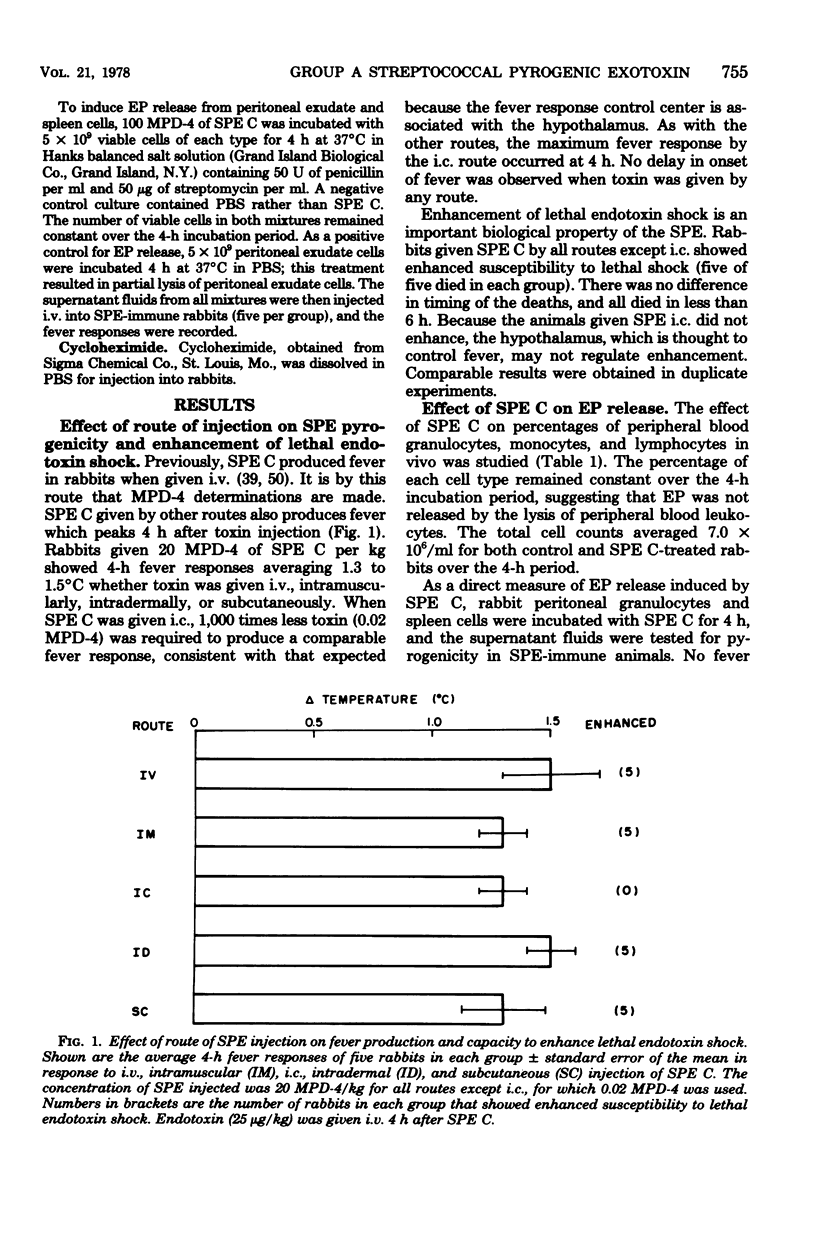
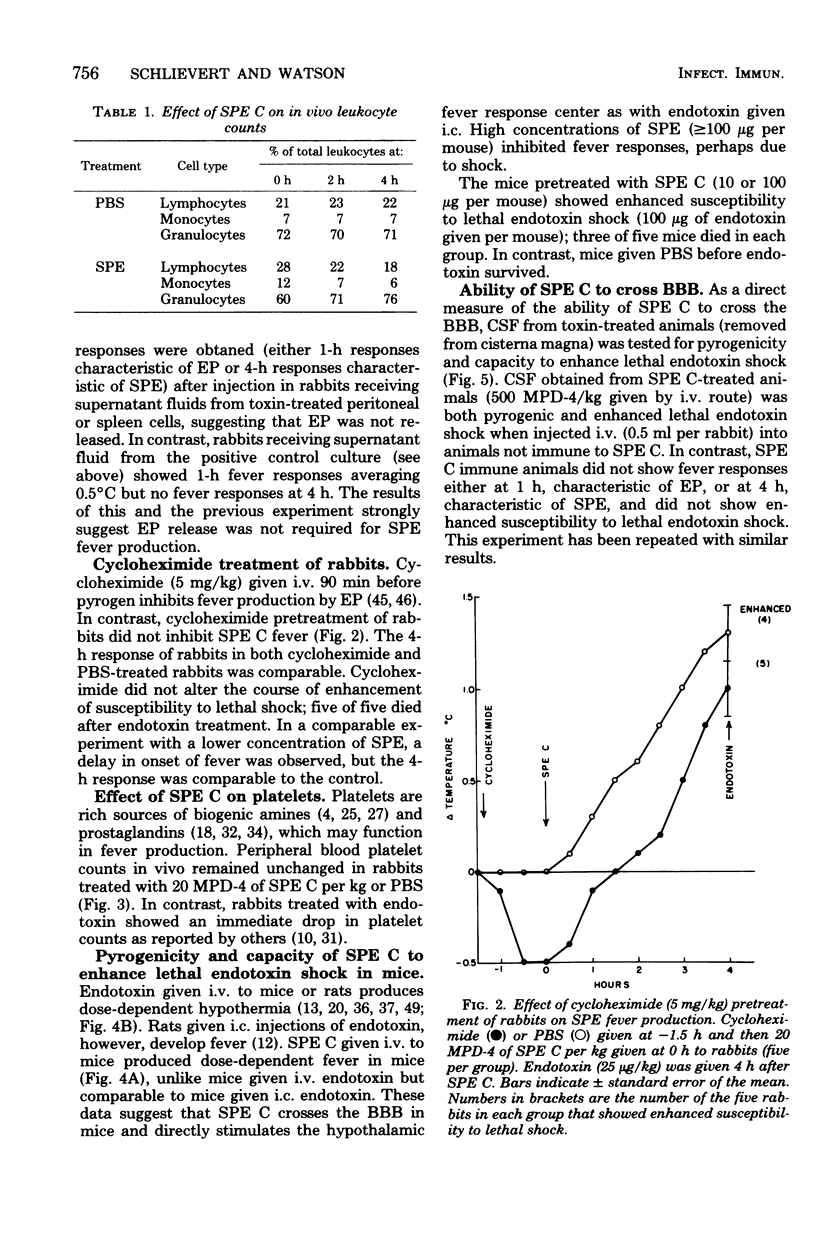
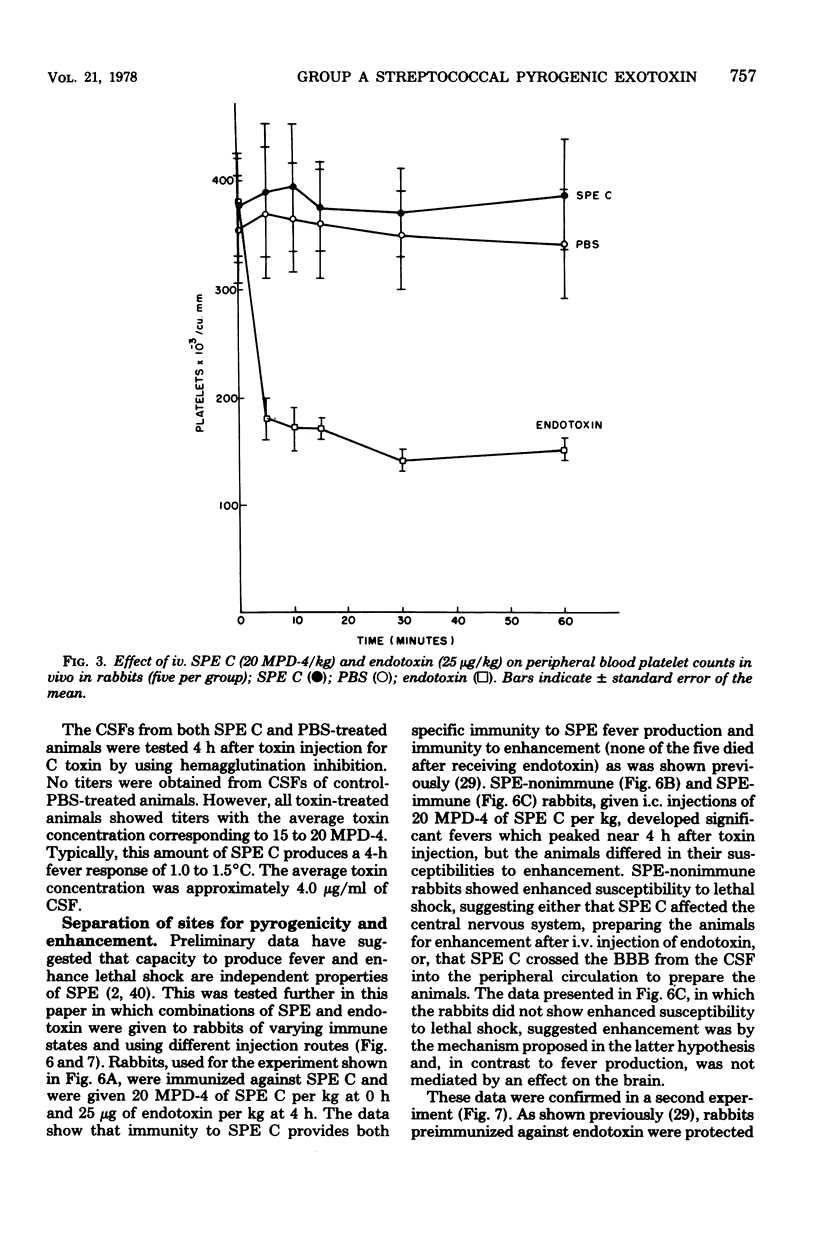

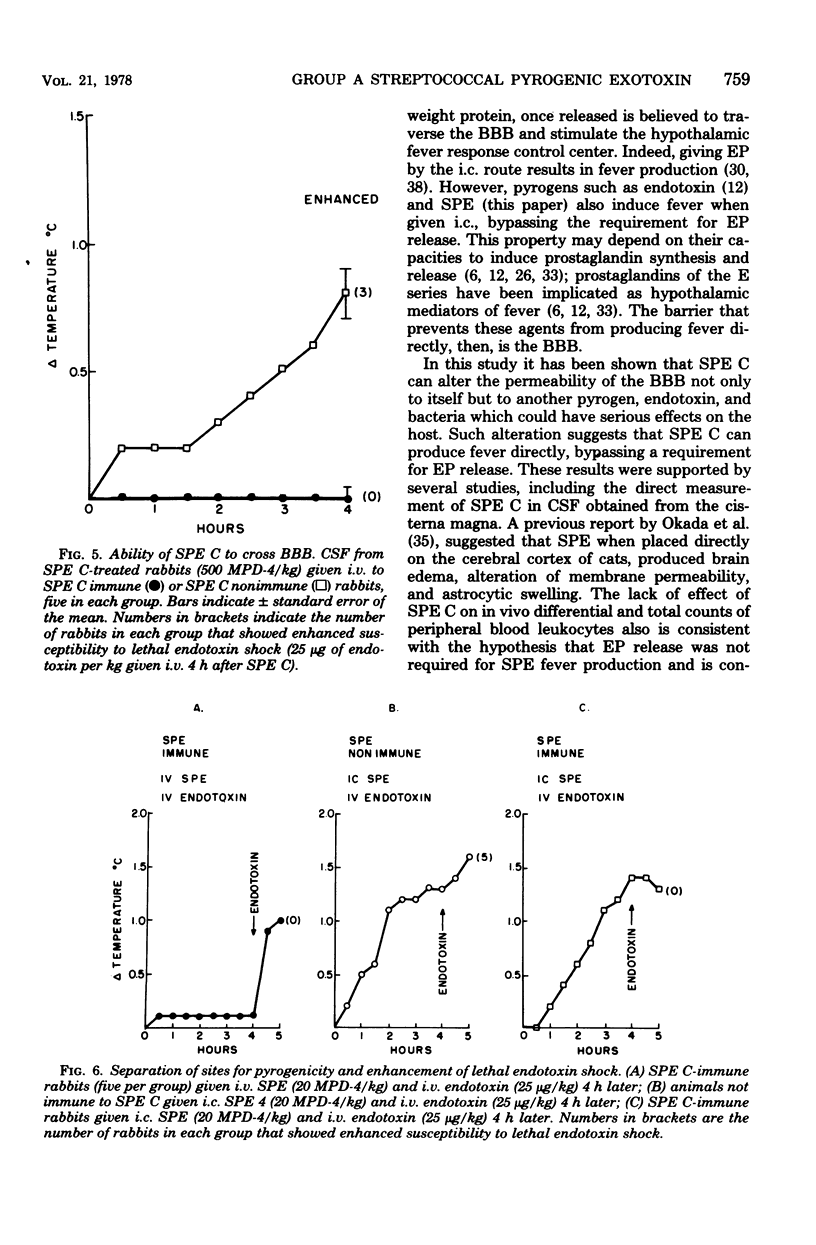


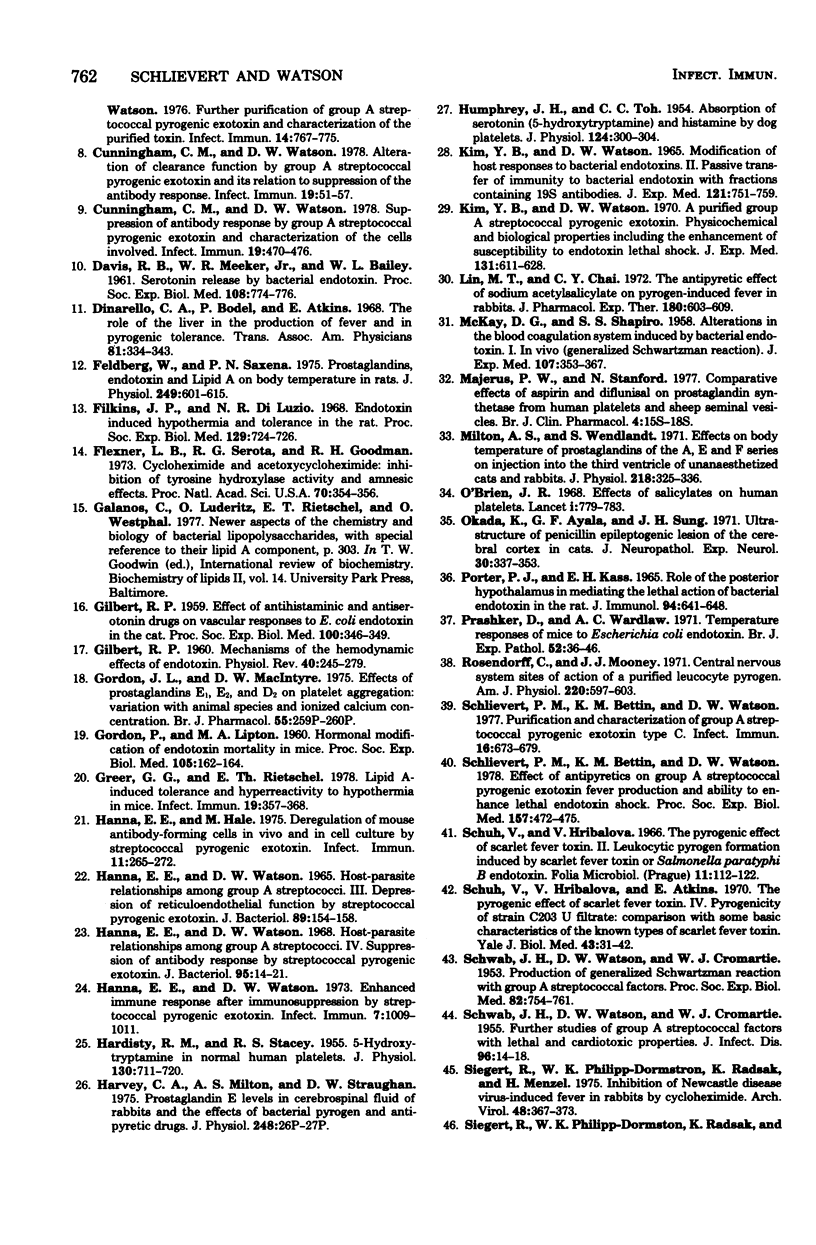
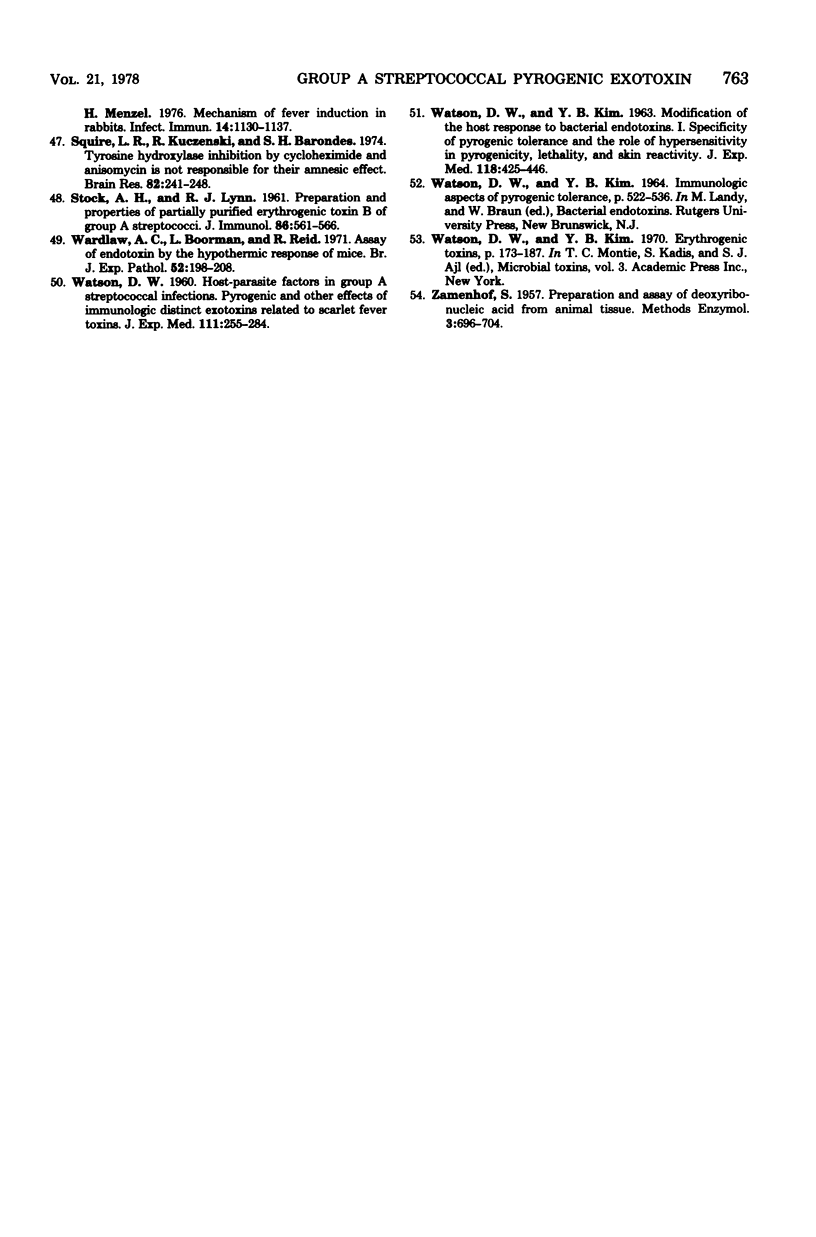
Selected References
These references are in PubMed. This may not be the complete list of references from this article.
- BORN G. V., GILLSON R. E. Studies on the uptake of 5-hydroxytryptamine by blood platelets. J Physiol. 1959 Jun 11;146(3):472–491. doi: 10.1113/jphysiol.1959.sp006206. [DOI] [PMC free article] [PubMed] [Google Scholar]
- Barsumian E. L., Cunningham C. M., Schlievert P. M., Watson D. W. Heterogeneity of group A streptococcal pyrogenic exotoxin type B. Infect Immun. 1978 May;20(2):512–518. doi: 10.1128/iai.20.2.512-518.1978. [DOI] [PMC free article] [PubMed] [Google Scholar]
- Bodel P., Miller H. Pyrogen from mouse macrophages causes fever in mice. Proc Soc Exp Biol Med. 1976 Jan;151(1):93–96. doi: 10.3181/00379727-151-39150. [DOI] [PubMed] [Google Scholar]
- Bradford M. M. A rapid and sensitive method for the quantitation of microgram quantities of protein utilizing the principle of protein-dye binding. Anal Biochem. 1976 May 7;72:248–254. doi: 10.1006/abio.1976.9999. [DOI] [PubMed] [Google Scholar]
- Clark W. G., Cumby H. R. The antipyretic effect of indomethacin. J Physiol. 1975 Jul;248(3):625–638. doi: 10.1113/jphysiol.1975.sp010992. [DOI] [PMC free article] [PubMed] [Google Scholar]
- Cunningham C. M., Barsumian E. L., Watson D. W. Further purification of group A streptococcal pyrogenic exotoxin and characterization of the purified toxin. Infect Immun. 1976 Sep;14(3):767–775. doi: 10.1128/iai.14.3.767-775.1976. [DOI] [PMC free article] [PubMed] [Google Scholar]
- Cunningham C. M., Watson D. W. Alteration of clearance function by group A streptococcal pyrogenic exotoxin and its relation to suppression of the antibody response. Infect Immun. 1978 Jan;19(1):51–57. doi: 10.1128/iai.19.1.51-57.1978. [DOI] [PMC free article] [PubMed] [Google Scholar]
- Cunningham C. M., Watson D. W. Suppression of antibody response by group A streptococcal pyrogenic exotoxin and characterization of the cells involved. Infect Immun. 1978 Feb;19(2):470–476. doi: 10.1128/iai.19.2.470-476.1978. [DOI] [PMC free article] [PubMed] [Google Scholar]
- DAVIS R. B., MEEKER W. R., Jr, BAILEY W. L. Serotonin release by bacterial endotoxin. Proc Soc Exp Biol Med. 1961 Dec;108:774–776. doi: 10.3181/00379727-108-27063. [DOI] [PubMed] [Google Scholar]
- Dinarello C. A., Bodel P. T., Atkins E. The role of the liver in the production of fever and in pyrogenic tolerance. Trans Assoc Am Physicians. 1968;81:334–344. [PubMed] [Google Scholar]
- Feldberg W., Saxena P. N. Prostaglandins, endotoxin and lipid A on body temperature in rats. J Physiol. 1975 Aug;249(3):601–615. doi: 10.1113/jphysiol.1975.sp011033. [DOI] [PMC free article] [PubMed] [Google Scholar]
- Filkins J. P., Di Luzio N. R. Endotoxin induced hypothermia and tolerance in the rat. Proc Soc Exp Biol Med. 1968 Dec;129(3):724–726. doi: 10.3181/00379727-129-33409. [DOI] [PubMed] [Google Scholar]
- Flexner L. B., Serota R. G., Goodman R. H. Cycloheximide and acetoxycycloheximide: inhibition of tyrosine hydroxylase activity and amnestic effects. Proc Natl Acad Sci U S A. 1973 Feb;70(2):354–356. doi: 10.1073/pnas.70.2.354. [DOI] [PMC free article] [PubMed] [Google Scholar]
- GILBERT R. P. Effect of antihistaminic and antiserotonin drugs on vascular responses to E. coli endotoxin in the cat. Proc Soc Exp Biol Med. 1959 Feb;100(2):346–349. doi: 10.3181/00379727-100-24622. [DOI] [PubMed] [Google Scholar]
- GILBERT R. P. Mechanisms of the hemodynamic effects of endotoxin. Physiol Rev. 1960 Apr;40:245–279. doi: 10.1152/physrev.1960.40.2.245. [DOI] [PubMed] [Google Scholar]
- GORDON P., LIPTON M. A. Hormonal modification of endotoxin mortality in mice. Proc Soc Exp Biol Med. 1960 Oct;105:162–164. doi: 10.3181/00379727-105-26045. [DOI] [PubMed] [Google Scholar]
- Gordon J. L., MacIntyre D. E. Proceedings: Effects of prostaglandins E1, E2 and D2 on platelet aggregation: variation with animal species and ionized calcium concentration. Br J Pharmacol. 1975 Oct;55(2):259P–260P. [PMC free article] [PubMed] [Google Scholar]
- Greer G. G., Rietschel E. T. Lipid A-induced tolerance and hyperreactivity to hypothermia in mice. Infect Immun. 1978 Feb;19(2):357–368. doi: 10.1128/iai.19.2.357-368.1978. [DOI] [PMC free article] [PubMed] [Google Scholar]
- HANNA E. E., WATSON D. W. HOST-PARASITE RELATIONSHIPS AMONG GROUP A STREPTOCOCCI. 3. DEPRESSION OF RETICULOENDOTHELIAL FUNCTION BY STREPTOCOCCAL PYROGENIC EXOTOXINS. J Bacteriol. 1965 Jan;89:154–158. doi: 10.1128/jb.89.1.154-158.1965. [DOI] [PMC free article] [PubMed] [Google Scholar]
- HARDISTY R. M., STACEY R. S. 5-Hydroxytryptamine in normal human platelets. J Physiol. 1955 Dec 29;130(3):711–720. doi: 10.1113/jphysiol.1955.sp005437. [DOI] [PMC free article] [PubMed] [Google Scholar]
- HUMPHREY J. H., TOH C. C. Absorption of serotonin (5-hydroxytryptamine) and histamine by dog platelets. J Physiol. 1954 May 28;124(2):300–304. doi: 10.1113/jphysiol.1954.sp005108. [DOI] [PMC free article] [PubMed] [Google Scholar]
- Hanna E. E., Hale M. Deregulation of mouse antibody-forming cells in vivo in cell culture by streptococcal pyrogenic exotoxin. Infect Immun. 1975 Feb;11(2):265–272. doi: 10.1128/iai.11.2.265-272.1975. [DOI] [PMC free article] [PubMed] [Google Scholar]
- Hanna E. E., Watson D. W. Enhanced immune response after immunosuppression by Streptococcal pyrogenic exotoxin. Infect Immun. 1973 Jun;7(6):1009–1011. doi: 10.1128/iai.7.6.1009-1011.1973. [DOI] [PMC free article] [PubMed] [Google Scholar]
- Hanna E. E., Watson D. W. Host-parasite relationships among group A streptococci. IV. Suppression of antibody response by streptococcal pyrogenic exotoxin. J Bacteriol. 1968 Jan;95(1):14–21. doi: 10.1128/jb.95.1.14-21.1968. [DOI] [PMC free article] [PubMed] [Google Scholar]
- Harvey C. A., Milton A. S., Straughan D. W. Proceedings: Prostaglandin E levels in cerebrospinal fluid of rabbits and the effects of bacterial pyrogen and antipyretic drugs. J Physiol. 1975 Jun;248(1):26P–27P. [PubMed] [Google Scholar]
- KIM Y. B., WATSON D. W. MODIFICATION OF HOST RESPONSES TO BACTERIAL ENDOTOXINS. II. PASSIVE TRANSFER OF IMMUNIY TO BACTERIAL ENDOTOXIN WITH FRACTIONS CONTAINING 19S ANTIBODIES. J Exp Med. 1965 May 1;121:751–759. doi: 10.1084/jem.121.5.751. [DOI] [PMC free article] [PubMed] [Google Scholar]
- Kim Y. B., Watson D. W. A purified group A streptococcal pyrogenic exotoxin. Physiochemical and biological properties including the enhancement of susceptibility to endotoxin lethal shock. J Exp Med. 1970 Mar 1;131(3):611–622. doi: 10.1084/jem.131.3.611. [DOI] [PMC free article] [PubMed] [Google Scholar]
- Lin M. T., Chai C. Y. The antipyretic effect of sodium acetylsalicylate on pyrogen-induced fever in rabbits. J Pharmacol Exp Ther. 1972 Mar;180(3):603–609. [PubMed] [Google Scholar]
- Majerus P. W., Stanford N. Comparative effects of aspirin and diflunisal on prostaglandin synthetase from human platelets and sheep seminal vesicles. Br J Clin Pharmacol. 1977 Feb;4 (Suppl 1):15S–18S. doi: 10.1111/j.1365-2125.1977.tb04509.x. [DOI] [PMC free article] [PubMed] [Google Scholar]
- McKAY D. G., SHAPIRO S. S. Alterations in the blood coagulation system induced by bacterial endotoxin. I. In vivo (generalized Shwartzman reaction). J Exp Med. 1958 Mar 1;107(3):353–367. doi: 10.1084/jem.107.3.353. [DOI] [PMC free article] [PubMed] [Google Scholar]
- Milton A. S., Wendlandt S. Effects on body temperature of prostaglandins of the A, E and F series on injection into the third ventricle of unanaesthetized cats and rabbits. J Physiol. 1971 Oct;218(2):325–336. doi: 10.1113/jphysiol.1971.sp009620. [DOI] [PMC free article] [PubMed] [Google Scholar]
- O'Brien J. R. Effects of salicylates on human platelets. Lancet. 1968 Apr 13;1(7546):779–783. doi: 10.1016/s0140-6736(68)92228-9. [DOI] [PubMed] [Google Scholar]
- Okada K., Ayala G. F., Sung J. H. Ultrastructure of penicillin-induced epileptogenic lesion of the cerebral cortex in cats. J Neuropathol Exp Neurol. 1971 Jul;30(3):337–353. doi: 10.1097/00005072-197107000-00003. [DOI] [PubMed] [Google Scholar]
- PORTER P. J., KASS E. H. ROLE OF THE POSTERIOR HYPOTHALAMUS IN MEDIATING THE LETHAL ACTION OF BACTERIAL ENDOTOXIN IN THE RAT. J Immunol. 1965 Apr;94:641–648. [PubMed] [Google Scholar]
- Prashker D., Wardlaw A. C. Temperature responses of mice to Escherichia coli endotoxin. Br J Exp Pathol. 1971 Feb;52(1):36–46. [PMC free article] [PubMed] [Google Scholar]
- Rosendorff C., Mooney J. J. Central nervous system sites of action of a purified leucocyte pyrogen. Am J Physiol. 1971 Mar;220(3):597–603. doi: 10.1152/ajplegacy.1971.220.3.597. [DOI] [PubMed] [Google Scholar]
- SCHWAB J. H., WATSON D. W., CROMARTIE W. J. Further studies of group A streptococcal factors with lethal and cardiotoxic properties. J Infect Dis. 1955 Jan-Feb;96(1):14–18. doi: 10.1093/infdis/96.1.14. [DOI] [PubMed] [Google Scholar]
- SCHWAB J. H., WATSON D. W., CROMARTIE W. J. Production of generalized Shwartzman reaction with group A streptococcal factors. Proc Soc Exp Biol Med. 1953 Apr;82(4):754–761. doi: 10.3181/00379727-82-20237. [DOI] [PubMed] [Google Scholar]
- Schlievert P. M., Bettin K. M., Watson D. W. Effect of antipyretics on group A streptococcal pyrogenic exotoxin fever production and ability to enhance lethal endotoxin shock. Proc Soc Exp Biol Med. 1978 Mar;157(3):472–475. doi: 10.3181/00379727-157-40079. [DOI] [PubMed] [Google Scholar]
- Schlievert P. M., Bettin K. M., Watson D. W. Purification and characterization of group A streptococcal pyrogenic exotoxin type C. Infect Immun. 1977 May;16(2):673–679. doi: 10.1128/iai.16.2.673-679.1977. [DOI] [PMC free article] [PubMed] [Google Scholar]
- Schuh V., Hríbalová V., Atkins E. The pyrogenic effect of scarlet fever toxin. IV. Pyrogenicity of strain C 203 U filtrate: comparison with some basic characteristics of the known types of scarlet fever toxin. Yale J Biol Med. 1970 Aug;43(1):31–42. [PMC free article] [PubMed] [Google Scholar]
- Schuh V., Hríbalová V. The pyrogenic effect of scarlet fever toxin. II. Leukocytic pyrogen formation induced by scarlet fever toxin or Salmonella paratyphi B endotoxin. Folia Microbiol (Praha) 1966;11(2):112–122. doi: 10.1007/BF02878839. [DOI] [PubMed] [Google Scholar]
- Siegert R., Philipp-Dormston W. K., Radsak K., Menzel H. Inhibition of Newcastle disease virus-induced fever in rabbits by cycloheximide. Arch Virol. 1975;48(4):367–373. doi: 10.1007/BF01317435. [DOI] [PubMed] [Google Scholar]
- Siegert R., Philipp-Dormston W. K., Radsak K., Menzel H. Mechanism of fever induction in rabbits. Infect Immun. 1976 Nov;14(5):1130–1137. doi: 10.1128/iai.14.5.1130-1137.1976. [DOI] [PMC free article] [PubMed] [Google Scholar]
- Squire L. R., Kuczenski R., Barondes S. H. Tyrosine hydroxylase inhibition by cycloheximide and anisomycin is not responsible for their amnesic effect. Brain Res. 1974 Dec 27;82(2):241–248. doi: 10.1016/0006-8993(74)90601-5. [DOI] [PubMed] [Google Scholar]
- WATSON D. W. Host-parasite factors in group A streptococcal infections. Pyrogenic and other effects of immunologic distinct exotoxins related to scarlet fever toxins. J Exp Med. 1960 Feb 1;111:255–284. doi: 10.1084/jem.111.2.255. [DOI] [PMC free article] [PubMed] [Google Scholar]
- WATSON D. W., KIM Y. B. MODIFICATION OF HOST RESPONSES TO BACTERIAL ENDOTOXINS. I. SPECIFICITY OF PYROGENIC TOLERANCE AND THE ROLE OF HYPERSENSITIVITY IN PYROGENICITY, LETHALITY, AND SKIN REACTIVITY. J Exp Med. 1963 Sep 1;118:425–446. doi: 10.1084/jem.118.3.425. [DOI] [PMC free article] [PubMed] [Google Scholar]
- Wardlaw A. C., Boorman L., Reid R. Assay of endotoxin by the hypothermic response of mice. Br J Exp Pathol. 1971 Apr;52(2):198–208. [PMC free article] [PubMed] [Google Scholar]


